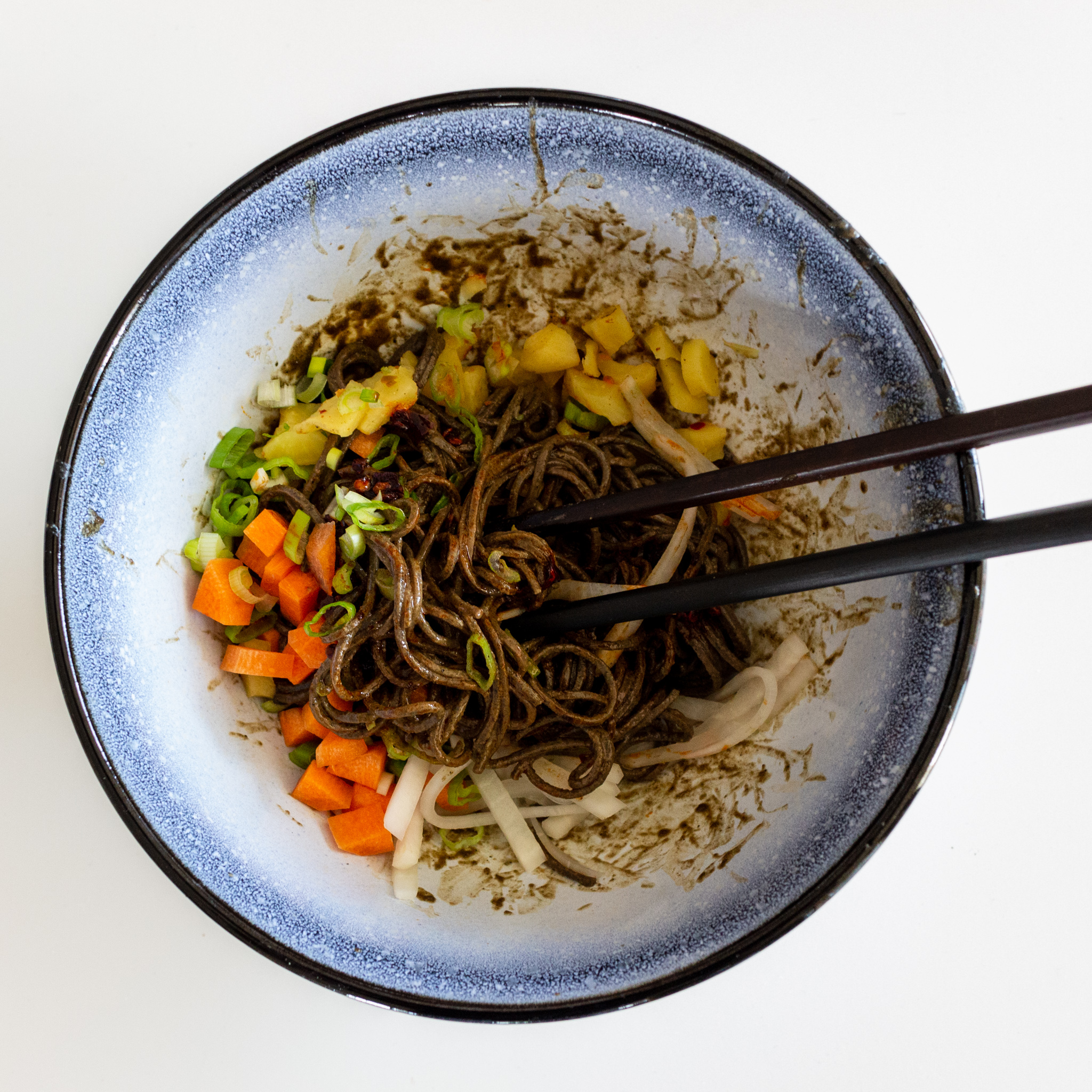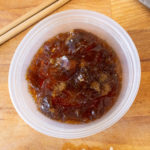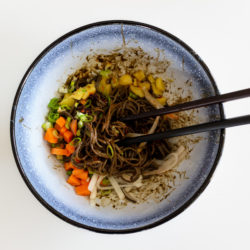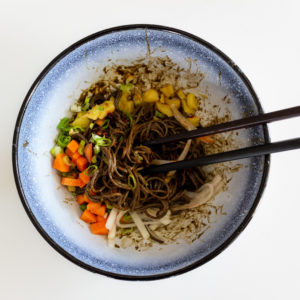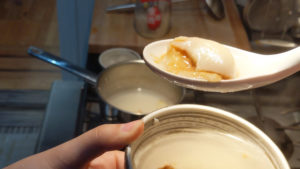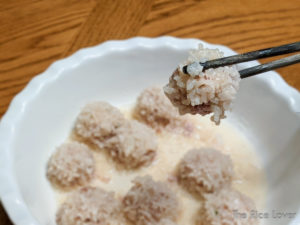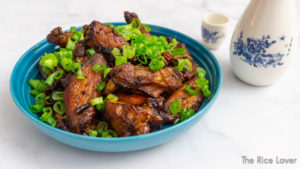Happy Mother’s Day! 祝天下所有的妈妈:母亲节快乐安康!This post is dedicated to my mother. Due to COVID-19, I was unable to spend the day with her, so I turned to hot dry noodles 热干面 (rè gān miàn) to bring me closer to 妈妈 (mā mā, mom) while social distancing. I hope you had the chance to enjoy a meal that reminds you of your mother too.
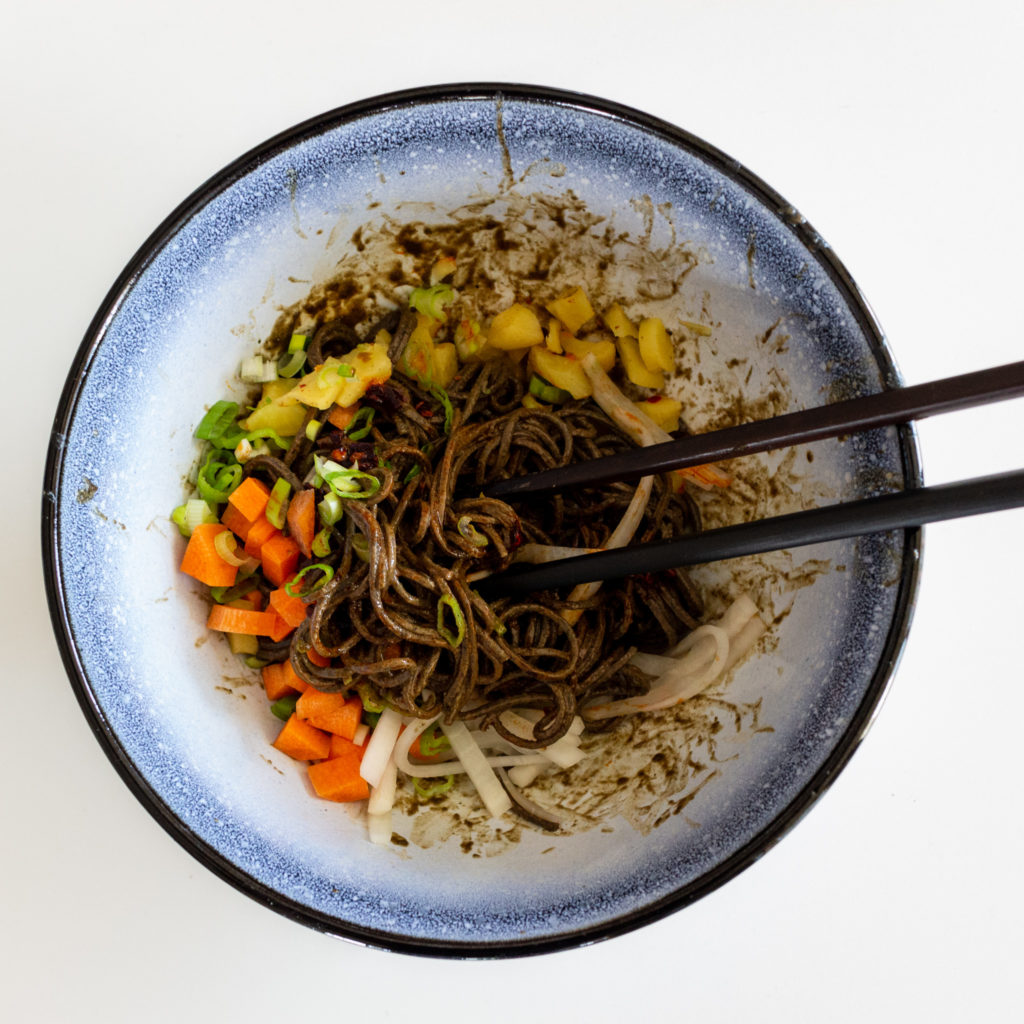
These days, you may have heard about 武汉 Wǔhàn for the first time in the news, but for me it’s a city I’ve known my whole life. My mother was born in Wuhan, and my parents met there in medical school. Gastronomically, Wuhan is famous for its breakfast culture, known locally as 过早 (guò zǎo), literally passing the morning. Every neighborhood in Wuhan has a cluster of its own vendors serving up a variety of breakfast 小吃 (xiǎo chī) small eats. Some of these breakfast street markets have existed in the same locations for hundreds of years.
Most mornings, the people of Wuhan stop by their local vendors to pick up fresh-made, delicious breakfast specialties like 豆皮 (dòu pí, a sticky rice omelette), 面窝 (miàn wō, savory rice flour doughnuts), 汤包 (soup dumpling with leavened dough), and 热干面 (rè gān miàn, hot dry noodles). Of these, my absolute favorite is. Of these, my absolute favorite is 热干面 hot dry noodles, a simple and comforting dish of springy noodles mixed with a sesame-based sauce.
Hot Dry Noodles? 热干面?
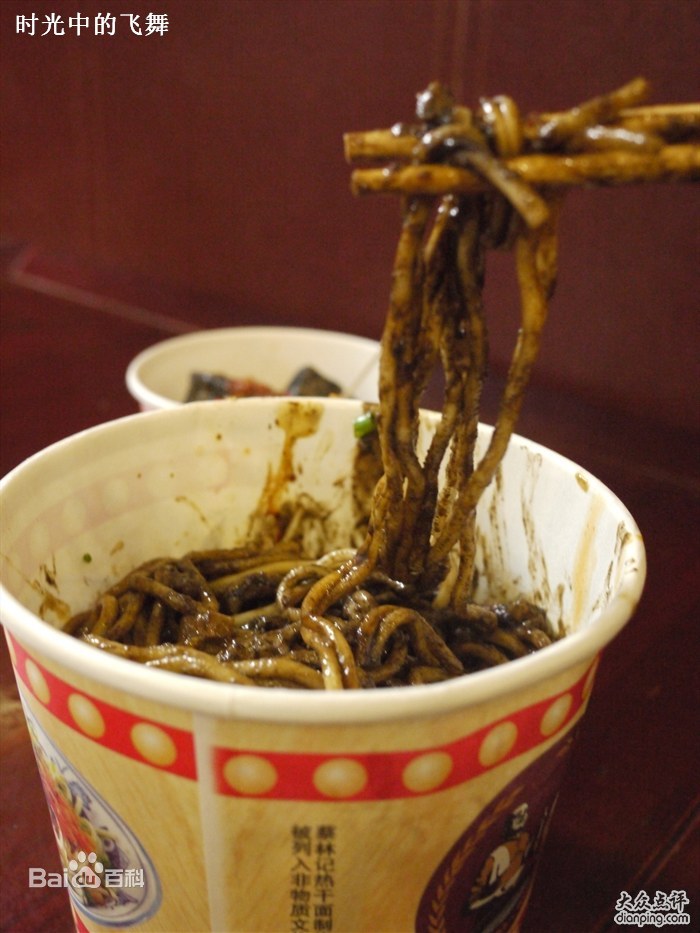
Cailinji, the most famous hot dry noodle shop (cr. Baidu)
The name here is very literal! Unlike many sesame noodles that are served cold, these are served hot. Most Chinese noodle dishes are served in soup or broth, but these are served in a rich sauce — which is the “dry” part of hot dry noodles.
In Wuhan reganmian shops, the noodles are par-cooked, tossed vigorously with sesame oil, and then cooled down. The sauce and topping elements are all prepped and set aside, and the sauce is mixed to your taste while the noodles get a quick dip in boiling water to finish cooking. That way, when you order your noodles, they can get your bowl of customized noodles to you in 30 seconds flat. They are always served in a slightly too small paper bowl, and in most shops you toss the noddles in the sauce yourself. Being able to execute this maneuver successfully makes you a true 武汉人 (wǔ hàn rén, Wuhan person).
In China’s venerable noodle culture, hot dry noodles are listed in the top 5:
- 北京炸酱面 (běi jīng zhá jiàng miàn) Beijing zhajiang “fried sauce” noodles
- 兰州拉面 (lán zhōu lā miàn) Lanzhou hand-pulled noodles
- 山西刀削面 (shān xī dāo xiāo miàn) Shanxi knife-cut noodles
- 四川担担面 (sì chuān dàn dàn miàn) Sichuan dan-dan noodles
- 武汉热干面 (wǔ hàn rè gān miàn) Wuhan hot dry noodles
Any Chinatown will generally have the first four available. For some reason, Wuhan hot dry noodles are much harder for me to find here in the US. Fortunately, for such a famous dish, hot dry noodles are surprisingly easy to make at home! I have also included substitutions for the authentic ingredients with readily available options from conventional grocery stores — head to the end of the post for a full list. Follow along and I promise no matter which of the options you pick, you’ll end up with a delicious meal for breakfast, lunch, or dinner!
The Noodles 面条: how to get perfect texture
Picking the Right Noodles
Traditionally, Wuhan hot dry noodles are made with a medium-thick, high-gluten, alkaline noodle. Let’s break down what that means and then decide how we can substitute. Gluten is the protein in wheat that gives dough elasticity, so this makes hot dry noodles bouncy and chewy.
枧水 or 碱水 (jiǎn shuǐ, alkaline water or Japanese kansui) increases the pH of the noodle, giving alkaline noodles their extra chewy and springy texture. See the trend here? — no soggy, spongy hot dry noodles! In Chinese, we say 嚼劲 (jiáo jìn, chew strength) or the popular slang term “Q” (pronounced as the English letter) or Q弹 (Q-tán).
Head’s up: This post may contain affiliate links: if you click through to purchase or sign up for something, I may earn a small commission. This is at no additional cost to you and helps me keep this site running. All sellers are ones I use myself. For more info, check out my policy here.
Another alkaline noodle that you may know is Japanese ramen 拉面 (fresh ramen, not instant noodles). A fresh ramen like Sun Noodles would be a great substitute to use in your hot dry noodles. They are rare, but I have seen dried ramen noodles like Yumei dried ramen noodles and unflavored (meaning no seasoning packet) instant alkaline noodles like Ottogi Plain Instant Noodles. I haven’t tried these particular brands, but you’re looking for a noodle with an alkaline agent like sodium carbonate.
There are also many recipes on the internet for how to make your own ramen or alkaline noodles. Most start with putting baking soda (sodium bicarbonate) in the oven to get sodium carbonate. Instead of making your own pasta, an easy hack is to boil ordinary spaghetti in baking soda — add 1 Tbsp of baking soda per quart of pasta cooking water. This is the easiest and most readily available substitution for most pantries, and I can vouch that it works very well with every grocery store dried wheat spaghetti I’ve tried.
Finally, the option I picked today was gluten-free black bean spaghetti (like Explore Asian Organic Black Bean Spaghetti also sold at Costco) cooked al-dente. Although this noodle doesn’t have the elasticity of high gluten flour, I’ve found that it has a nice chewy texture that is perfect for modified hot dry noodles.
Don’t worry if this seems complicated, all of the options are summarized at the end of this post!
Cooking the Noodles
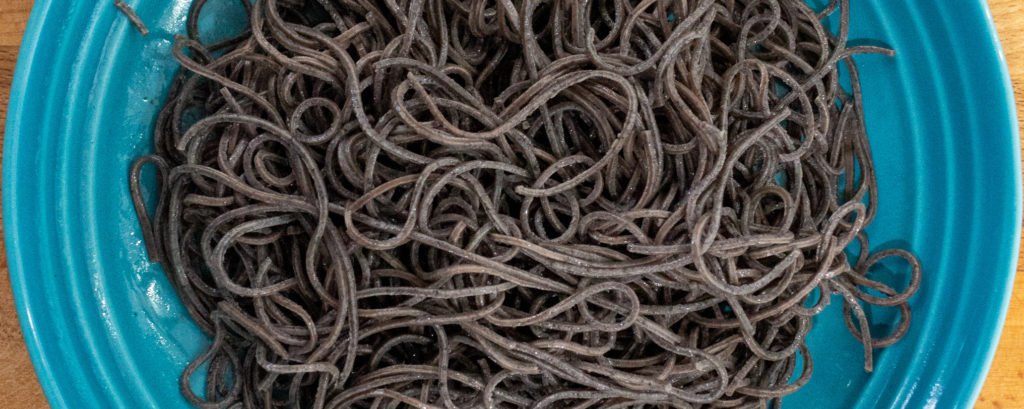
Black bean spaghetti, tossed with sesame oil to prevent clumping
Regardless of which option you choose, cook the noodles to al dente or toothsome. Many boxes give cook times for both al dente and regular; if not, under-cook by about a minute. Drain the noodles well, and toss with 1/2 tsp sesame oil per serving. You want to move the noodles around quite a bit while tossing to ensure they don’t clump together as they cool.
The Sauces 热干面酱: Hot Dry Noodles are not actually dry
Unless we’re talking about martinis, dry is rarely a good thing in food. Fortunately, there’s plenty of saucy goodness going on in hot dry noodles, just no soup!
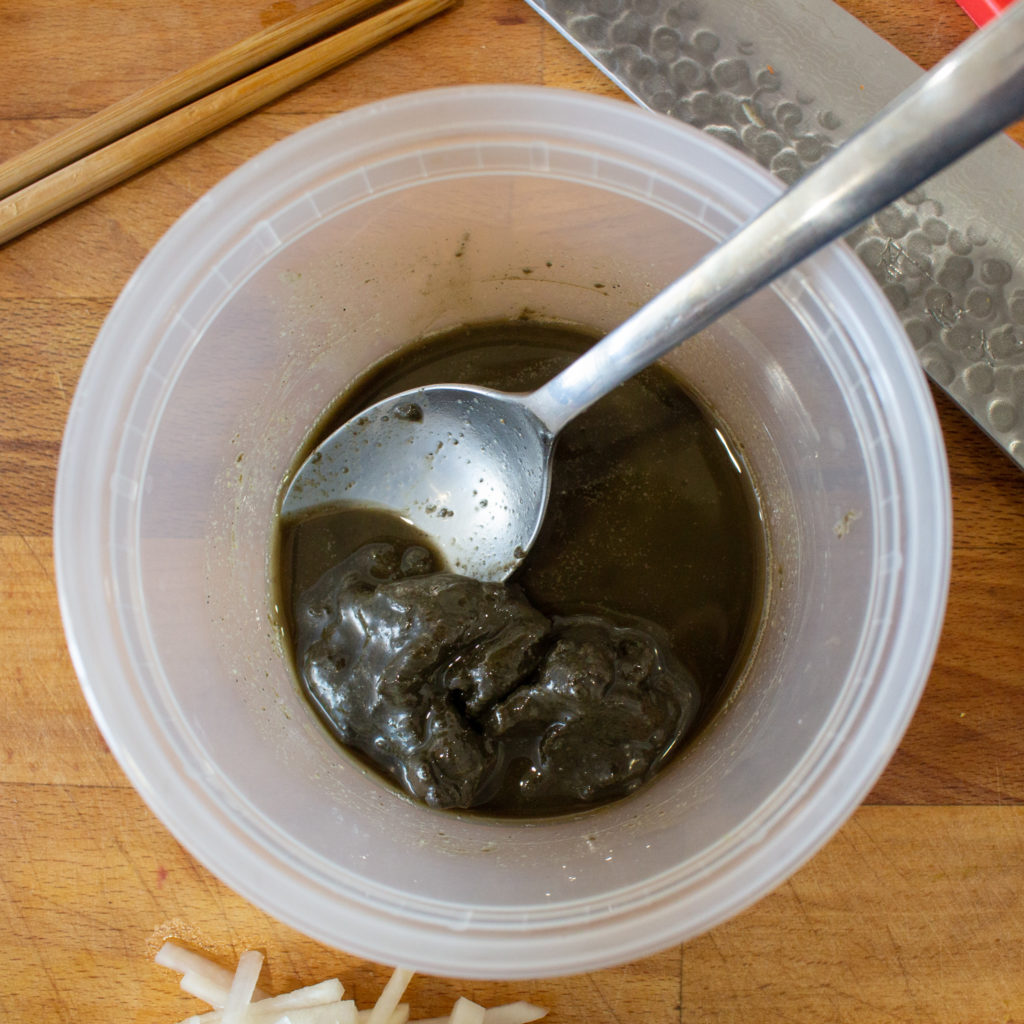
Sesame sauce (sesame paste + sesame oil), before mixing 芝麻酱汁 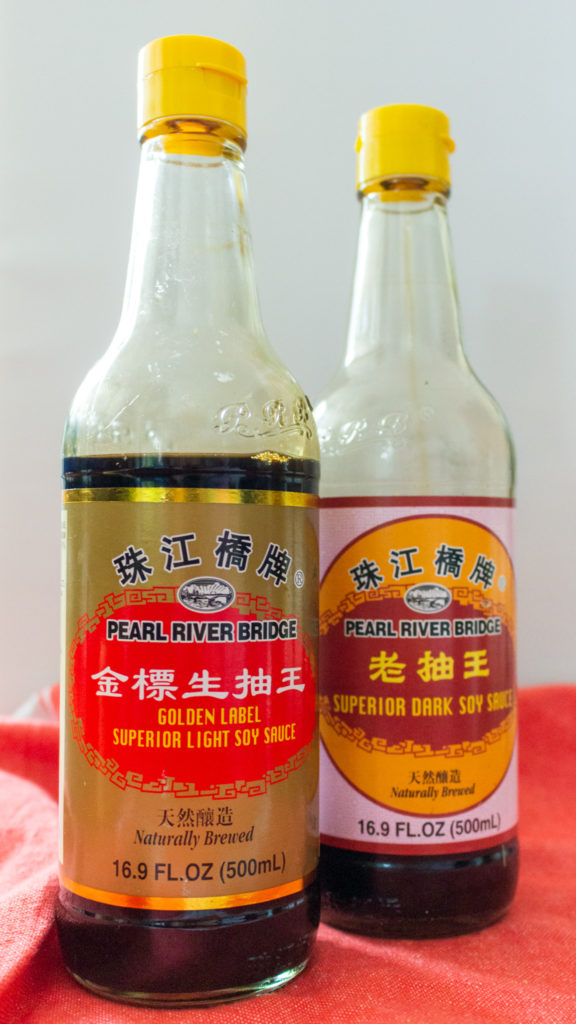
Mixed soy sauce: light soy sauce, dark soy sauce, sugar 酱油汁(生抽,老抽,糖) 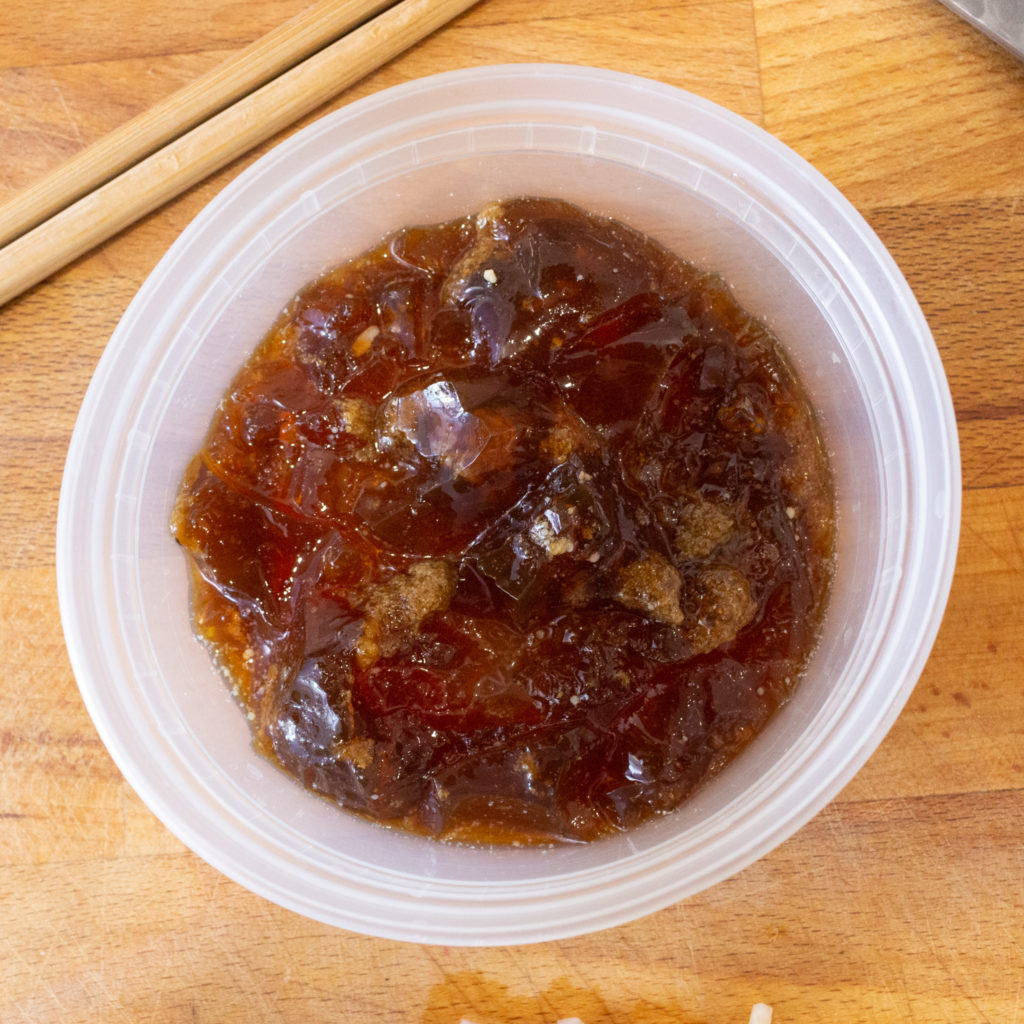
“Secret sauce” braising liquid, notice the gelatin gives it the texture of jello when chilled 卤汁
The sauce for hot dry noodles is straightforward if you have all the items in my essential ingredients series. The ratios and ingredients will differ slightly from one vendor to another, but my recipe is based on the most famous of them all, 蔡林记 (cài lín jì) Cailinji! This is the noodle chain founded by the original inventor of hot dry noodles 蔡明纬 Cài Míngjué, who perfected the recipe during World War II.
Sesame Sauce 芝麻酱汁
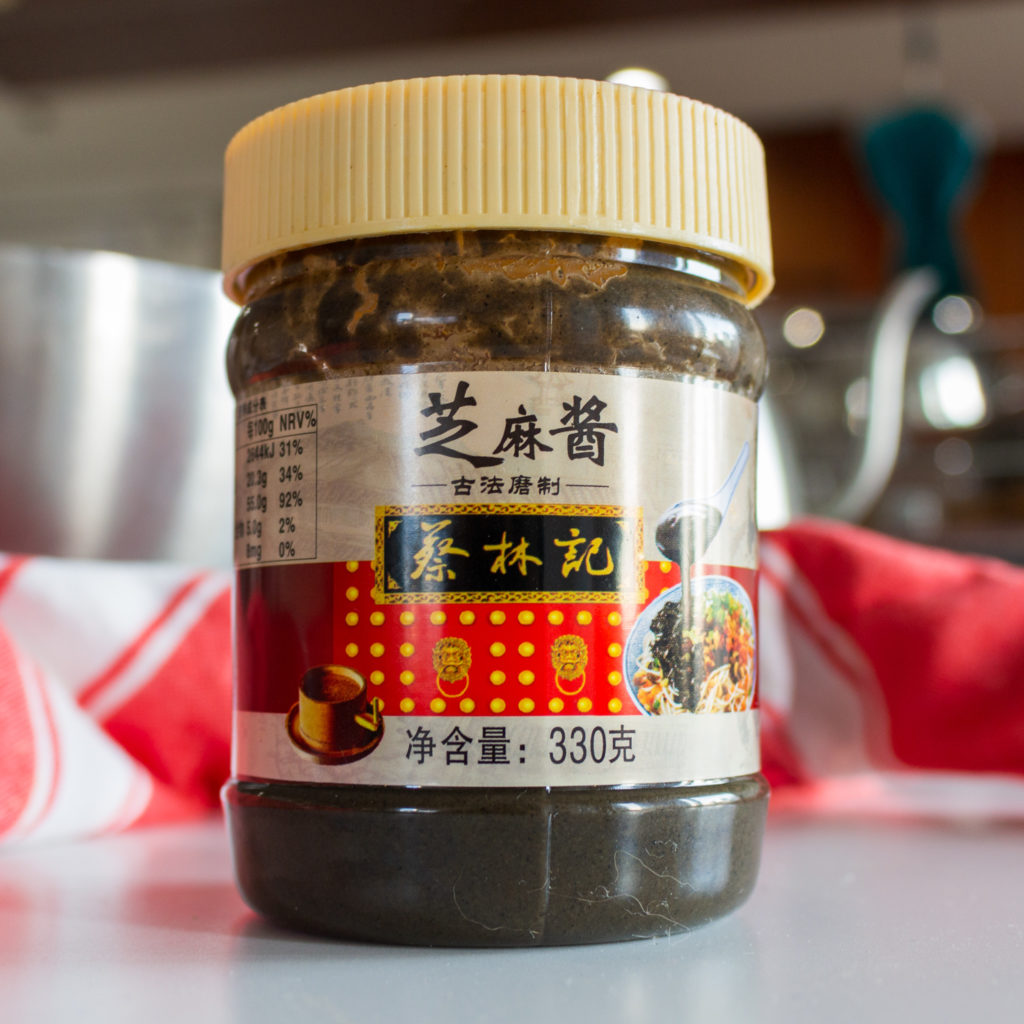
Almost all savory Chinese cooking uses white sesame paste, but Cailijin uses 黑芝麻将 (hēi zhī má jiàng) black sesame paste. A good pure sesame paste (Chinese, or toasted) is perfect. If you don’t have sesame paste, substitute mild tahini, peanut butter, or a 50/50 mix of the two. To thin out the sesame paste, we’ll combine it with 麻油 (má yóu) sesame oil to thin it out to a luscious sauce that perfectly coats the noodles. I used a 3:1 ratio of paste to oil, but you may need to add more sesame oil if your sesame paste is on the drier side. The final texture should be smooth and pourable like heavy cream.
Mixed Soy Sauce 酱油汁
The second sauce component is a soy-sauce mixture of 4 parts 生抽 light soy sauce, 2 parts 老抽 dark soy sauce, and 1 part 白糖 (bái táng) sugar. Mix these together in a separate bowl, and set aside. If you don’t have dark soy sauce, you can use a ratio of 5 parts light soy sauce to 1 part sugar.
Secret Ingredient: Soy-Braising Liquid 秘密武器:卤水
The final sauce component, and the secret to a really delicious hot dry noodle is 卤水 (lǔ shuǐ), braising liquid left from cooking 卤肉 (lǔ ròu) soy-braised meat (beef shanks are traditional). The liquid is full of dissolved gelatin from the meat, which makes for a rich and glossy mouthfeel in our hot dry noodles. I’ll do a post for 卤肉 soy-braised meat in the future — the braising liquid can be used over and over again with the addition more liquid and fresh spices to make extra-flavorful 老卤汁 (lǎo lǔ zhī) old braising liquid.
For today’s dish though, we can also make a quick “un-braising” liquid without simmering meat for hours. The addition of unflavored gelatin 明胶 (míng jiāo) replicates the cooked-for-hours mouthfeel of 卤水. To make quick un-braising liquid:
Toppings 配菜
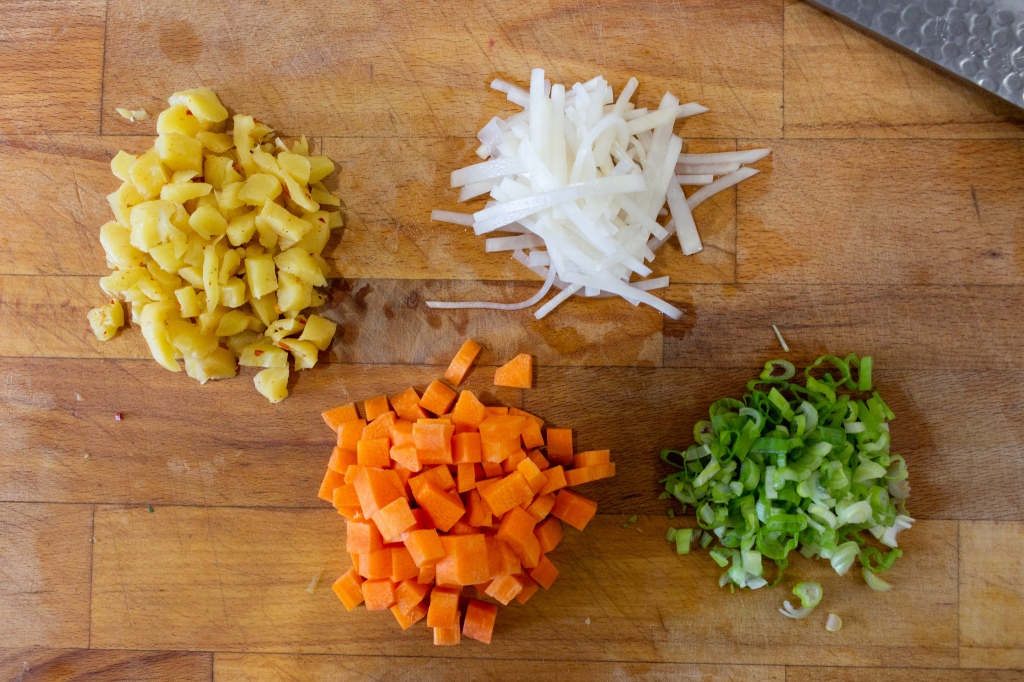
In Wuhan hot dry noodle shops, the toppings are finely diced and set out for customers to add to their own taste. Traditional toppings add texture, spice, acid (brightness), or freshness, such as:
- freshness: 葱花 (cōng huā) minced scallions
- flavor and crunch: 萝卜干 (luó bó gān) preserved daikon radish and carrots — use a mix of preserved radish 老板菜 (lǎo bǎn cài) / 榨菜 (zhà cài) and raw carrots 胡萝卜 (hú luó bó)
- crunch and acid: 酸豆角 (suān dòu jiǎo) spicy pickled long beans — use any pickle you have on hand, like quick-pickled daikon or pickled peppers
- crunch: 炒花生米 (chǎo huā shēng mǐ) roasted peanuts
- spice: 辣椒油 (là jiāo yóu) chili oil — like Laoganma chili oil 老干妈油辣椒
- acid: 香醋 (xiāng cù) Chinese black vinegar
What you add on top is totally up to you, add as many or as few as you like. The most important element here to get authentic Wuhan flavor would be some sort of preserved vegetable. These shelf-stable nuggets of flavor and crunch are available at any Asian grocery store. Some pictures of options I found at my local Ranch 99 are below.

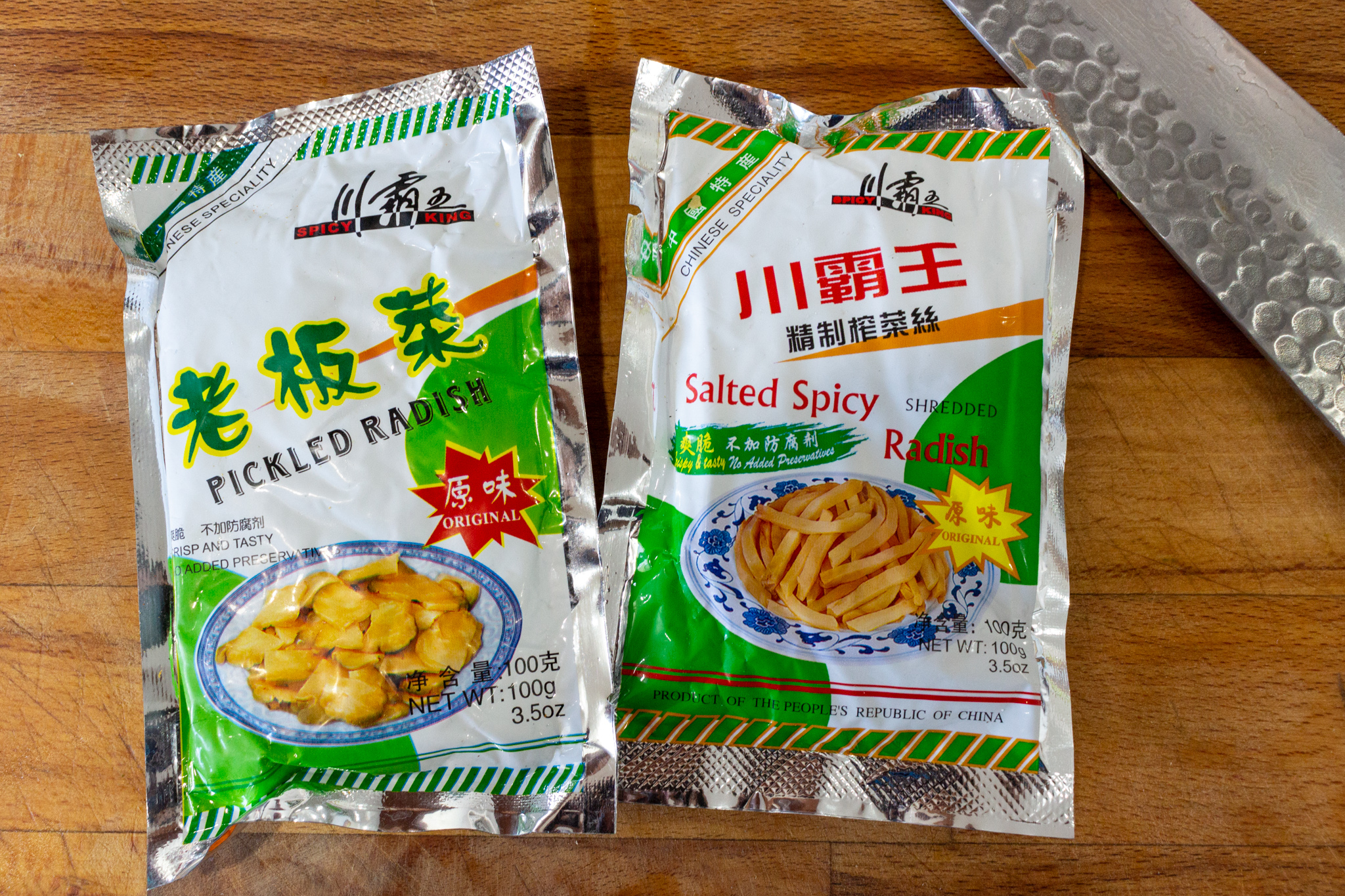
Assembly 合并: choose your own adventure
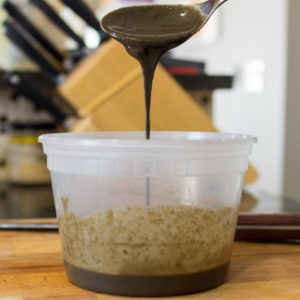
This is the consistency we’re targeting for the sesame sauce — creamy but pourable 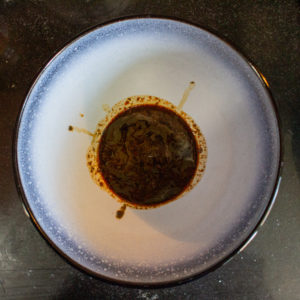
Add your three sauces to the bottom of the bowl 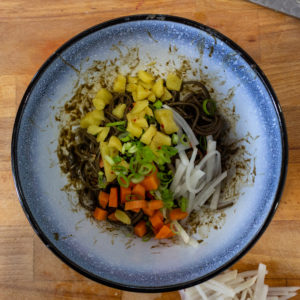
Add your chosen toppings, and toss well to coat
This is the fun part! Add 2-3 Tbsp of sesame sauce mix, 1 Tbsp of soy sauce mix, 1.5 Tbsp of “secret sauce” braising liquid to the bottom of a bowl. Add in 1 serving of noodles (tossed in sesame oil). Top with toppings of your choice; I recommend 1-2 tsp of each to start, and then add more per your own taste.
Mix it all up so that the noodles are well-coated in sauce, and enjoy a quick and easy bowl of famous Wuhan hot dry noodles!
Substitutions: All the ways to make Hot Dry Noodles your own
High-Gluten, Alkaline Noodles
- fresh ramen noodles, like Sun Noodles
- homemade ramen noodles
- instant/dry alkaline noodles
- regular spaghetti, cooked in 1 Tbsp baking soda per 1 qt water
- black bean spaghetti, like Explore Asian
Black Sesame Paste
- (white) pure sesame paste
- unsalted creamy peanut butter
- mild tahini, like Soom, Barron’s Organic, Trader Joe’s
- 50/50 mix of mild tahini and PB
Spicy Pickled Long Beans
- quick-pickled daikon radish
- any crunchy quick pickle
- any spicy pickle, like pickled banana peppers
Preserved Radish
Look for the text below at the Asian grocery, usually sold in foil packets. They may be called “preserved radish” or “salted spicy radish” or “pickled radish”. The traditional flavor is spicy chili oil, but any one works.
- 萝卜干 (luó bó gān)
- 榨菜 (zhà cài)
- 老板菜 (láo bán cài)
“Secret Sauce” Braising Liquid
- reserved liquid from 卤肉 soy-braised meat
- soy “Un-braising” liquid, my recipe above
- combine 2:1 soy sauce mixture and oyster sauce 蠔油 (háo yóu)
- replace with soy sauce mixture
Wuhan Hot Dry Noodles 武汉热干面
Ingredients
- 1 serving high-gluten alkaline noodles
see Substitutions 碱面,1份 - 2 Tbsp sesame sauce as below 芝麻酱汁,2汤勺(如下)
- 1 Tbsp mixed soy sauce as below 酱油汁,1汤勺(如下)
- 1½ Tbsp "secret sauce" braising liquid warmed (see recipe above) 热卤水,1汤勺(见以上食谱)
- 1 tsp toppings of choice each, as few or as many as you like 配菜,以下,按个人口味
Sesame sauce 食材:芝麻酱汁
- 3 Tbsp sesame paste preferably black sesame paste (see Substitutions) 黑芝麻将,3汤勺
- 1 Tbsp sesame oil plus more as needed for consistency 麻油,适量(约1汤勺)
Mixed soy sauce 食材:酱油汁
- 4 tsp light soy sauce 生抽酱油,4勺
- 2 tsp dark soy sauce 老抽酱油,2勺
- 1 tsp sugar 白糖,1勺
Toppings for serving 配料
- scallions minced 葱花
- preserved radish 1/4-inch dice (see ”Substitutions“) 萝卜干,切丁
- raw carrots 1/4-inch dice 胡萝卜,切丁
- spicy pickled long beans (see ”Substitutions“), cut into 1/4-inch segments 酸豆角,切丁
- roasted peanuts chopped 炒花生米,切碎
- chili oil like Laoganma 辣椒油
- Chinkiang (Chinese black) vinegar 香醋
Instructions
Sesame sauce 做法:芝麻酱汁
- Combine 3 parts sesame paste with 1 part sesame oil. Stir vigorously in 1 direction until smooth. The consistency should creamy and pourable. If it's too thick, slowly add more sesame oil and continue stirring until it has the consistency of heavy cream.芝麻将和麻油按3比1的比列,向一个方向搅拌。芝麻酱汁调成糊状,按需要添加麻油继续调稀。

Mixed soy sauce 做法:酱油汁
- Combine 4 parts light soy sauce, 2 parts dark soy sauce, 1 part sugar. Stir thoroughly.生抽,老抽,白糖以4比2比1的比列,搅拌均匀
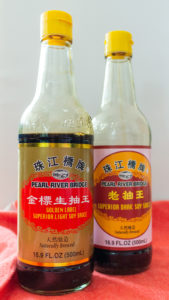
Assembly 做法:合并
- Add 2 Tbsp sesame sauce, 1 Tbsp mixed soy sauce , and 1 Tbsp secret sauce to the bottom of a bowl.碗底加入2汤勺芝麻酱汁,1汤勺酱油汁,1汤勺卤水

- Cook noodles to al-dente according to package instructions (approx. 1 min less than standard cooking instructions)将碱面煮熟,注意保持嚼劲,避免煮烂
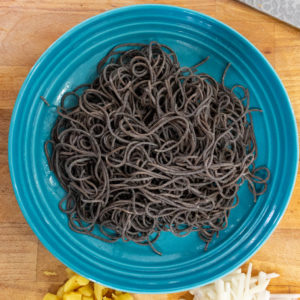
- Drain noodles, and toss with 1/2 tsp of sesame oil per serving of noodles. It's important to toss thoroughly here to prevent the noodles from sticking.面条从锅里捞出,每份淋上半茶勺麻油,筷子挑散。注意为了防止相粘并保持嚼劲一定要搅拌均匀。

- Add prepared noodles to the bowl. Top with toppings to taste, approximately 1-2 tsp of each碗里加入过油碱面1份。撒上配料,可按个人口味添加
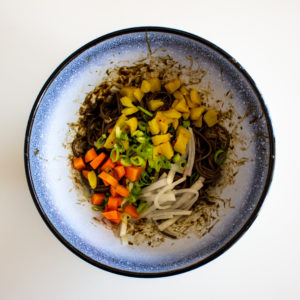
- Mix thoroughly so that noodles are well-coated with sauce将面,酱汁,和配料拌匀

